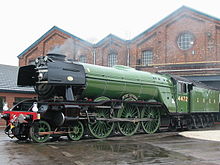Doncaster Works

Doncaster Railway Works is a railway workshop located in Doncaster, England.
Also referred to as The Plant, it was established by the
History
In 1866, Patrick Stirling was appointed as Locomotive Superintendent, and the first of the 875 class was built in 1886. At this time the works also began building new coaches: in 1873 the first sleeping cars; in 1879 the first dining cars in the United Kingdom; and in 1882 the first corridor coaches. In 1891, 99 locomotives, 181 carriages and 1,493 wagons were built.
In 1889 a separate building for carriages was opened and wagon construction ceased at Doncaster in 1890, and by 1913 all of the work relating to coaches was concentrated in three buildings including a construction facility with 12 roads.[1]
Among the
In 1913 "The Plant" employed 4600 and covered 200 acres (81 ha)
In 1957, BR Standard Class 4 76114, the last of 2,228 steam locomotives, was completed.[4][5] In November 1963 60009 Union of South Africa was the last of an estimated 10,000 steam locomotives to be overhauled at Doncaster Works.[6] Carriage building finished in 1962, but the works was modernised with the addition of a diesel locomotive repair shop. Under British Rail Engineering Limited, new diesel shunters and 25 kV electric locomotives were built, plus Class 56 and Class 58 diesel-electric locomotives.
In October 1987, the wagon works was sold by the
In 2007, Bombardier Transportation closed its part of the works.[9][10] In early 2008 the main locomotive repair shop which was built on the Crimpsall was demolished to make way for housing. Wabtec continues to conduct carriage refurbishment at the Doncaster site.[11]
See also
Notes
- ^ There was a previous claim of a British locomotive reaching 100 mph, and even over 90 years later the competing claims can still produce heated debate. More information can be found at GWR 3700 Class 3440 City of Truro#Speed record
References
Citations
- ^ Harris 1973, p. 15.
- ^ Harris 1973, p. 16.
- ISSN 1753-2469.
- ^ "Last Steam Locomotive Built at Doncaster". Railway Gazette. No. 25 October 1957. p. 490.
- ^ "End of an Era at Doncaster". The Railway Magazine. No. 680. December 1957. p. 819.
- ^ "Last Steam Overhaul at Doncaster". The Railway Magazine. No. 752. December 1963. p. 118.
- Rail Express. No. 25. June 1988. p. 11.
- Rail Magazine. No. 380. 5 April 2000. p. 13.
- ^ Closure at Plant Works means end of the line for 150 years of history Archived 14 April 2019 at the Wayback Machine Doncaster Free Press 20 December 2007
- Sheffield Star20 December 2007
- ^ Keeping the Wheels in Motion Archived 26 February 2019 at the Wayback Machine Wabtec
References
- Harris, Michael (1973). Gresley's coaches. Newton Abbot: David & Charles. ISBN 0-7153-5935-5.
Further reading
- Larkin, E. J.; Larkin, J. G. (1988). The Railway Workshops of Great Britain 1823-1986. Macmillan Press.
- Simmons, J. (1986). The Railway in Town and Country. Newton Abbot: David & Charles.
- Clarke, Derek (March 1986). "Doncaster Works: The changing scene". OCLC 49957965.
- Roughley, Malcolm (November 1983). "A day at 'The Plant'". OCLC 49957965.
